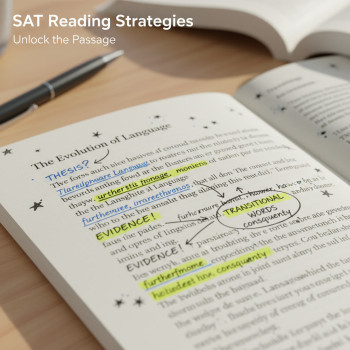Why a Relaxation Routine Matters After SAT Study Sessions
You just closed your math workbook, set down the last practice test, and for a moment you feel empty — relief, fatigue, and a tiny pulse of anxiety all wrapped in one. That moment is the perfect cue for a cooldown routine. Just as athletes don’t sprint from the track into the locker room and call it a day, your brain benefits from a deliberate transition from intense study to restful recovery.
A relaxation routine after SAT study sessions does more than soothe sore thoughts. It helps consolidate memory, reduces stress hormones like cortisol, improves sleep quality, and keeps your motivation steady across long-term preparation. In short: a small investment in recovery pays off in sharper recall and better mental resilience on test day.
The Science of Recovery: Why Rest Helps Learning
When you learn something new, your brain encodes information into short-term memory. Consolidation — the process that cements short-term memories into long-term storage — happens best when you give the brain a chance to breathe. Adequate rest, offline reflection, and low-stress activities create the biochemical and neural environment conducive to memory stabilization.
Research in cognitive psychology shows that spacing study sessions apart and including breaks improves retention more than marathon cramming. Similarly, recovery practices (like relaxation, sleep, and gentle movement) help reduce the interference that erases freshly learned material. So instead of seeing relaxation as optional, treat it as part of the study strategy.
Designing a Relaxation Routine That Fits You
There’s no one-size-fits-all cooldown. The best routine matches your energy levels, schedule, and what genuinely helps you unwind. Use the following guide to build a flexible, repeatable routine that you’ll actually stick with:
Step 1: Decide When to Cool Down
- Short sessions (30–60 minutes): 5–10 minute cooldowns are powerful.
- Moderate sessions (60–120 minutes): 10–20 minutes of structured recovery is ideal.
- Long sessions (practice tests, 3+ hours): allow 20–45 minutes and prioritize sleep or a quality nap later.
Step 2: Choose Two to Three Reliable Reset Tools
Pick a small toolkit of activities that consistently work for you. Rotate them so they stay fresh.
- Breathing or grounding exercises
- Light movement (walk, stretch, yoga)
- Creative pause (sketching, journaling, listening to a favorite song)
- Mental detox (phone-free time, warm drink, nature view)
Step 3: Keep It Simple and Repeatable
Routines stick when they’re short, simple, and tied to a cue. Make the cue your last study action — closing a book, stopping a timer, or logging a score. Repeat the same three-step cooldown for at least two weeks and you’ll notice how effortlessly your brain starts switching gears.
Practical Cooldown Techniques — What to Do, Step by Step
Below are approachable techniques you can mix and match. Each one is evidence-informed and student-tested.
1) The 4-7-8 Breathing Reset
Why it works: Controlled breathing engages the parasympathetic nervous system, lowering heart rate and quieting anxious thoughts.
- Sit comfortably. Close your eyes.
- Inhale quietly through your nose for 4 seconds.
- Hold for 7 seconds.
- Exhale completely for 8 seconds.
- Repeat 3–6 cycles.
Example: After a tough Reading section, take this two-minute pause. You’ll come back calmer and ready to review mistakes with perspective.
2) Progressive Muscle Relaxation (PMR)
Why it works: Tensing and releasing muscle groups reduces bodily tension and helps the mind settle.
- Start at your feet and work upward.
- Tense each muscle group for 5–8 seconds, then relax for 15–20 seconds.
- Move slowly: feet → calves → thighs → hips → stomach → chest → hands → arms → neck → face.
Tip: Use PMR after long problem-solving sessions in Math to release neck and shoulder tension.
3) Active Recovery: Walk + Sensory Reset
Why it works: Movement boosts blood flow to the brain and a change of scenery reduces mental fatigue.
- Take a 10–20 minute walk outside if possible.
- Focus on sensory details: colors, sounds, textures — not your score.
- If outdoors isn’t available, walk a block in your home or do dynamic stretches in place.
4) The 5-Minute Reflection Journal
Why it works: Writing helps organize thoughts and extract lessons from a study session without rumination.
- Write three lines: What I accomplished, what confused me, one clear next step.
- Keep it short. This isn’t therapy; it’s triage for your study plan.
Example: After a practice test, jot: “Completed Math section; need to review trig questions 5–10; tomorrow: 20 minutes focused on sine/cosine formulas.”
5) The Reward Ritual
Why it works: Pairing study with consistent, small rewards builds positive reinforcement.
- Pick a non-distracting reward: a cup of tea, 15 minutes of a favorite podcast, or a short sketch.
- Use rewards sparingly so they remain motivating.
How Long Should a Cooldown Be? A Simple Table
Match relaxation length to session intensity. This table gives a quick reference you can adapt to your schedule.
| Study Session Length | Recommended Cooldown | Suggested Activities |
|---|---|---|
| 30–60 minutes | 5–10 minutes | Breathing exercises, 5-minute walk, short journal |
| 60–120 minutes | 10–20 minutes | Light stretching, PMR, snack + sensory reset |
| 3–5 hours (practice test) | 20–45 minutes + rest later | Long walk, nap (20–30 min), reflective journaling |
Evening Recovery: Protecting Your Sleep After Evening Study
Studying late can feel productive, but late-night stimulation harms sleep quality — and sleep is when the brain does heavy consolidation. An evening cooldown prepares your mind for rest and helps lock in what you learned.
Guidelines for a Sleep-Friendly Routine
- Stop intense studying at least 60–90 minutes before bed.
- Turn off screens or use blue-light filters in that last hour.
- Choose calming activities: warm shower, herbal tea, reading for pleasure (not study), or gentle stretching.
- If anxious thoughts intrude, try the 5-minute reflection journal to transfer them to paper.
Pro tip: A consistent bedtime anchor (like dimming lights and a 10-minute breathing practice) cues your brain that sleep time is coming, making falling asleep easier and improving overall learning retention.
Nutrition and Hydration: Small Habits, Big Returns
What you eat and drink during recovery matters. Dehydration and heavy, sugary snacks can make you sluggish and foggy. Simple choices support both relaxation and later study performance.
- Hydrate first: a glass of water after a session helps reset cognition.
- Choose balanced snacks: fruit with nuts, yogurt, or whole-grain toast with peanut butter.
- Avoid heavy meals right before bed; opt for light, protein-rich options if you’re studying late.
Example: After an afternoon practice test, a banana and a handful of almonds paired with a short walk is a pleasant, brain-friendly cooldown.
Social Recovery: How People Help You Recharge
Relaxation doesn’t have to be solo. Connecting with friends or family is a powerful way to recover — but choose intentionally.
- Quick social checks work: a 10-minute call with a friend or a laugh with a sibling can diffuse tension.
- Avoid long debates about score details right after a test — that can re-stimulate anxiety.
- Consider study buddies who share the cooldown ritual, like a post-session walk or a quick gratitude round.
Sample Routines — Build One That Fits Your Life
Below are three sample cooldowns you can borrow and adapt. Each one is designed for realistic student schedules.
Quick 10-Minute Reset (After a 45–60 Minute Session)
- 0:00–0:30 — Close the study app/tablet, write one sentence: “Main win/next step.”
- 0:30–3:30 — 4-7-8 breathing (3 cycles).
- 3:30–6:30 — 3–4 minutes of stretching or a short walk in the hallway.
- 6:30–10:00 — Small reward (tea, favorite song, or 10 minutes off-screen).
Moderate 20-Minute Reset (After a 2-Hour Session)
- 0:00–2:00 — 5-minute reflection journal: wins, confusions, tomorrow’s plan.
- 2:00–10:00 — 8-minute walk outside; focus on five sensory details.
- 10:00–16:00 — Progressive muscle relaxation: upper body focus.
- 16:00–20:00 — Hydrate + light snack.
Deep Recovery (After Full-Length Practice Test)
- First 30 minutes — Do nothing study-related. Walk, shower, or sit with a drink.
- Next 20–30 minutes — Short nap (20 min) or rest with dim lights; if you nap, set an alarm.
- Later — Brief review: 15–30 min of targeted analysis (only the highest-yield mistakes), then a calm evening routine to protect sleep.
Integrating Relaxation with Your Study Strategy
Recovery is most effective when it’s part of a larger study plan. If you’re working with a prep program or a tutor, make your cooldown routine part of the plan so your schedule supports both learning and rest.
For students who use Sparkl’s personalized tutoring, this integration is natural: tutors can design practice blocks that end with specific cooldown prompts, recommend tailored study lengths based on your stamina, and use AI-driven insights to spot when you’re plateauing and need more recovery. Those small adjustments — 1-on-1 guidance, tailored study plans, expert tutors — can keep your preparation sustainable and effective.
Dealing with Common Obstacles
Here are solutions to barriers students often face when trying to add relaxation to their routine.
Obstacle: “I don’t have time for a cooldown.”
Solution: Start with 3 minutes. Even short, intentional pauses produce benefits. Use micro-routines like one breathing cycle or a 1-minute stretch between tasks.
Obstacle: “Cooldowns make me procrastinate.”
Solution: Make cooldowns conditional rewards. Only take the tea or the walk after you’ve completed a focused block. That keeps relaxation tied to productivity.
Obstacle: “I can’t relax; I feel guilty.”
Solution: Reframe relaxation as study strategy. Remind yourself that rest improves performance and prevents burnout. Track how your focus improves on days you use a cooldown to reinforce the behavior.
Tracking Progress: Keep It Honest and Gentle
Measure the impact of your routine with simple markers, not rigid metrics. Notes to your journal like “slept better,” “felt calmer during review,” or “made fewer careless errors” are meaningful. If you work with a tutor or a program, share these observations — they help tutors tailor guidance and pacing. When Sparkl’s tutors pair those observations with AI-driven insights, you can get actionable suggestions about when to intensify practice or prioritize more recovery.
Final Thoughts: Routine, Not Ritual — Keep It Flexible
A relaxation routine is a promise to your future test-taking self: a way of caring for the part of you that needs rest to perform. The best routines are portable: they work in the library, at home, or between school classes. They’re small enough to be sustainable and flexible enough to evolve as your needs change.
Start with one micro-routine tonight. Try a 4-7-8 breathing session or a 5-minute walk after your next study block. Notice the difference in mood and recall. Over time, these small moments of rest will add up to clearer thinking, steadier nerves, and a study experience that doesn’t burn you out before the SAT even arrives.
Two Image Ideas to Pair with This Article


Relaxation after study is not a distraction from progress; it’s part of the path to it. With a few deliberate tools, a little planning, and occasional support from personalized tutoring like Sparkl’s (1-on-1 guidance, tailored study plans, and expert tutors who use AI-driven insights), you’ll show up to practice and test day clearer, calmer, and more capable than you were yesterday. Take the pause — your brain will thank you.
















No Comments
Leave a comment Cancel